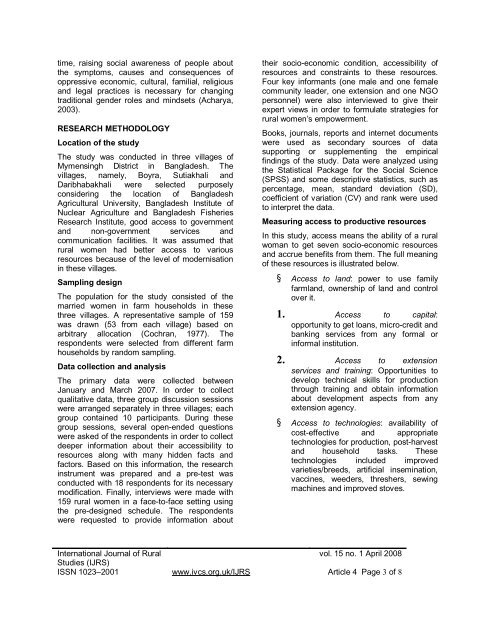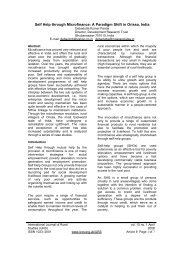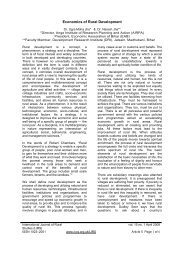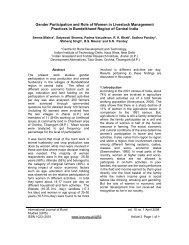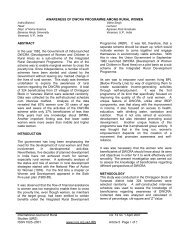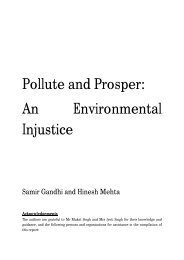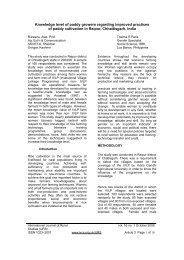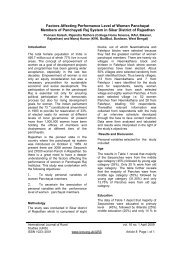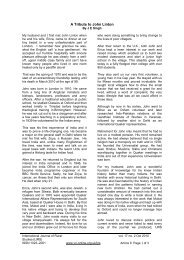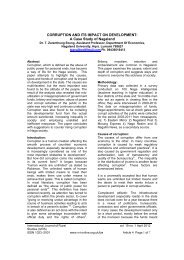(Anon., 1995). Despite their tremendouscontribution <strong>to</strong> food production and well-be<strong>in</strong>g forthe household, <strong>rural</strong> <strong>women</strong> are underestimatedand overlooked <strong>in</strong> development strategies.Various socio-cultural and structural barriersaffect their access <strong>to</strong> formal and non-formal<strong>in</strong>stitutions and extension services (Murshid andYasmeen, 2004).It is praiseworthy that the government <strong>of</strong><strong>Bangladesh</strong> has adopted a national policy for theadvancement <strong>of</strong> <strong>women</strong> s<strong>in</strong>ce 1997. Forimprov<strong>in</strong>g the socio-economic condition <strong>of</strong><strong>women</strong>, the efforts <strong>of</strong> different NGOs are alsovery significant. Various development agencieshave undertaken some <strong>in</strong>itiatives andprogrammes focus<strong>in</strong>g on education and skilldevelopment, credit, health and nutrition, politicalempowerment, gender awareness, human rightsand oppression. Some <strong>in</strong>novative steps like freeeducation for girls with special stipends,reservation <strong>of</strong> seats for <strong>women</strong> <strong>in</strong> localgovernment, special quota <strong>in</strong> services andamendment <strong>of</strong> laws have been promot<strong>in</strong>g<strong>women</strong>’s empowerment as well as reduc<strong>in</strong>g thegender disparity. However, <strong>women</strong>’s propertyrights are highly constra<strong>in</strong>ed <strong>in</strong> <strong>Bangladesh</strong>, as itis governed by religious laws. Under the MuslimLaw, a daughter <strong>in</strong>herits one-half the share <strong>of</strong>her brother, a wife receives only one-eighth <strong>of</strong>the deceased husband’s property while a mothergets one-sixth (ADB, 2001; Ramachandran,2006). Due <strong>to</strong> lack <strong>of</strong> land ownership, <strong>women</strong> aregett<strong>in</strong>g <strong>in</strong>adequate attention by manydevelopment agencies. For example, theagricultural extension delivery services <strong>in</strong><strong>Bangladesh</strong> are still concentrated on malefarmers and consequently, fail <strong>to</strong> reach themajority <strong>of</strong> <strong>rural</strong> <strong>women</strong> with modern <strong>in</strong>formationand technologies.<strong>Access</strong> <strong>to</strong> <strong>resources</strong> is one <strong>of</strong> the elements <strong>of</strong><strong>women</strong>’s empowerment and a base for theatta<strong>in</strong>ment <strong>of</strong> the Millennium Development Goals(MDGs). Many <strong>in</strong>ternational conferences havebeen held <strong>to</strong> improve <strong>rural</strong> <strong>women</strong>’s equitableaccess <strong>to</strong> and control <strong>of</strong> land and property <strong>in</strong>recent years. The United Nations has outl<strong>in</strong>edseven <strong>in</strong>terdependent strategic priorities withregard <strong>to</strong> MDG-3 <strong>in</strong> alter<strong>in</strong>g discrim<strong>in</strong>ationaga<strong>in</strong>st <strong>women</strong>. Two strategies are <strong>to</strong> ensure<strong>women</strong>’s property and <strong>in</strong>heritance rights and <strong>to</strong>elim<strong>in</strong>ate gender <strong>in</strong>equality <strong>in</strong> economic sec<strong>to</strong>rs(World Bank, 2007). The 4th World Congress <strong>of</strong>Rural Women, held <strong>in</strong> South Africa <strong>in</strong> 2007,reiterated the need <strong>to</strong> provide full and equalaccess for <strong>rural</strong> <strong>women</strong> <strong>to</strong> <strong>productive</strong> <strong>resources</strong>,<strong>in</strong>clud<strong>in</strong>g the right <strong>to</strong> <strong>in</strong>heritance and ownership<strong>of</strong> land and other property, credit/capital,appropriate technologies, markets and<strong>in</strong>formation. Consider<strong>in</strong>g this complex situation,the researcher attempted <strong>to</strong> exam<strong>in</strong>e some <strong>of</strong>the <strong>productive</strong> <strong>resources</strong> accessible <strong>to</strong> <strong>rural</strong><strong>women</strong> and explore enabl<strong>in</strong>g and limit<strong>in</strong>g fac<strong>to</strong>rs,with the <strong>in</strong>tention <strong>of</strong> mak<strong>in</strong>g them powerfulagents for change over time.THEORETICAL FOCUS<strong>Access</strong> is the right or opportunity <strong>to</strong> use, manageor control a particular resource (Nichols et al.,1999). Resources may be economic (e.g. landand credit), political (e.g. participation <strong>in</strong> localgovernment and community decision-mak<strong>in</strong>g)and social (e.g. education and tra<strong>in</strong><strong>in</strong>g). Ingeneral, <strong>women</strong> and men require different levels<strong>of</strong> access <strong>to</strong> <strong>resources</strong> based on their<strong>productive</strong>, re<strong>productive</strong> and communitymanag<strong>in</strong>g roles (Moser, 1993). Whendisadvantaged <strong>women</strong> have the ability <strong>to</strong> controltheir own environment by ga<strong>in</strong><strong>in</strong>g greater access<strong>to</strong> material and <strong>in</strong>tellectual <strong>resources</strong>,Musokotwane et al. (2001) have called thisprocess ‘empowerment’.Many studies have already found that access <strong>to</strong><strong>productive</strong> <strong>resources</strong> for <strong>women</strong> enhancesknowledge on farm management and <strong>in</strong>comegeneration, develops barga<strong>in</strong><strong>in</strong>g and decisionmak<strong>in</strong>gpower, improves children’s school<strong>in</strong>gand health, <strong>in</strong>creases self-confidence and socialnetworks and provides security <strong>in</strong> old age(IFPRI, 2000; Grace, 2005; Pitt et al., 2006).Poverty alleviation <strong>in</strong> <strong>rural</strong> areas is significantlyrelated <strong>to</strong> <strong>women</strong>’s <strong>in</strong>creased access <strong>to</strong><strong>productive</strong> <strong>resources</strong> (Adereti, 2005). Thus,efforts <strong>to</strong> build social capital among <strong>rural</strong> <strong>women</strong>are necessary for susta<strong>in</strong>able production andhousehold food security through provision <strong>of</strong>facilitat<strong>in</strong>g <strong>resources</strong> (Meludu et al., 1999; Flora,2001). All ac<strong>to</strong>rs <strong>in</strong> development must providethem with support <strong>in</strong> this regard. At the sameInternational Journal <strong>of</strong> Ruralvol. 15 no. 1 April 2008Studies (IJRS)ISSN 1023–2001 www.ivcs.org.uk/IJRS Article 4 Page 2 <strong>of</strong> 8
time, rais<strong>in</strong>g social awareness <strong>of</strong> people aboutthe symp<strong>to</strong>ms, causes and consequences <strong>of</strong>oppressive economic, cultural, familial, religiousand legal practices is necessary for chang<strong>in</strong>gtraditional gender roles and m<strong>in</strong>dsets (Acharya,2003).RESEARCH METHODOLOGYLocation <strong>of</strong> the studyThe study was conducted <strong>in</strong> three villages <strong>of</strong>Mymens<strong>in</strong>gh District <strong>in</strong> <strong>Bangladesh</strong>. Thevillages, namely, Boyra, Sutiakhali andDaribhabakhali were selected purposelyconsider<strong>in</strong>g the location <strong>of</strong> <strong>Bangladesh</strong>Agricultural University, <strong>Bangladesh</strong> Institute <strong>of</strong>Nuclear Agriculture and <strong>Bangladesh</strong> FisheriesResearch Institute, good access <strong>to</strong> governmentand non-government services andcommunication facilities. It was assumed that<strong>rural</strong> <strong>women</strong> had better access <strong>to</strong> various<strong>resources</strong> because <strong>of</strong> the level <strong>of</strong> modernisation<strong>in</strong> these villages.Sampl<strong>in</strong>g designThe population for the study consisted <strong>of</strong> themarried <strong>women</strong> <strong>in</strong> farm households <strong>in</strong> thesethree villages. A representative sample <strong>of</strong> 159was drawn (53 from each village) based onarbitrary allocation (Cochran, 1977). Therespondents were selected from different farmhouseholds by random sampl<strong>in</strong>g.Data collection and analysisThe primary data were collected betweenJanuary and March 2007. In order <strong>to</strong> collectqualitative data, three group discussion sessionswere arranged separately <strong>in</strong> three villages; eachgroup conta<strong>in</strong>ed 10 participants. Dur<strong>in</strong>g thesegroup sessions, several open-ended questionswere asked <strong>of</strong> the respondents <strong>in</strong> order <strong>to</strong> collectdeeper <strong>in</strong>formation about their accessibility <strong>to</strong><strong>resources</strong> along with many hidden facts andfac<strong>to</strong>rs. Based on this <strong>in</strong>formation, the research<strong>in</strong>strument was prepared and a pre-test wasconducted with 18 respondents for its necessarymodification. F<strong>in</strong>ally, <strong>in</strong>terviews were made with159 <strong>rural</strong> <strong>women</strong> <strong>in</strong> a face-<strong>to</strong>-face sett<strong>in</strong>g us<strong>in</strong>gthe pre-designed schedule. The respondentswere requested <strong>to</strong> provide <strong>in</strong>formation abouttheir socio-economic condition, accessibility <strong>of</strong><strong>resources</strong> and constra<strong>in</strong>ts <strong>to</strong> these <strong>resources</strong>.Four key <strong>in</strong>formants (one male and one femalecommunity leader, one extension and one NGOpersonnel) were also <strong>in</strong>terviewed <strong>to</strong> give theirexpert views <strong>in</strong> order <strong>to</strong> formulate strategies for<strong>rural</strong> <strong>women</strong>’s empowerment.Books, journals, reports and <strong>in</strong>ternet documentswere used as secondary sources <strong>of</strong> datasupport<strong>in</strong>g or supplement<strong>in</strong>g the empiricalf<strong>in</strong>d<strong>in</strong>gs <strong>of</strong> the study. Data were analyzed us<strong>in</strong>gthe Statistical Package for the Social Science(SPSS) and some descriptive statistics, such aspercentage, mean, standard deviation (SD),coefficient <strong>of</strong> variation (CV) and rank were used<strong>to</strong> <strong>in</strong>terpret the data.Measur<strong>in</strong>g access <strong>to</strong> <strong>productive</strong> <strong>resources</strong>In this study, access means the ability <strong>of</strong> a <strong>rural</strong>woman <strong>to</strong> get seven socio-economic <strong>resources</strong>and accrue benefits from them. The full mean<strong>in</strong>g<strong>of</strong> these <strong>resources</strong> is illustrated below.• <strong>Access</strong> <strong>to</strong> land: power <strong>to</strong> use familyfarmland, ownership <strong>of</strong> land and controlover it.1. <strong>Access</strong> <strong>to</strong> capital:opportunity <strong>to</strong> get loans, micro-credit andbank<strong>in</strong>g services from any formal or<strong>in</strong>formal <strong>in</strong>stitution.2. <strong>Access</strong> <strong>to</strong> extensionservices and tra<strong>in</strong><strong>in</strong>g: Opportunities <strong>to</strong>develop technical skills for productionthrough tra<strong>in</strong><strong>in</strong>g and obta<strong>in</strong> <strong>in</strong>formationabout development aspects from anyextension agency.• <strong>Access</strong> <strong>to</strong> technologies: availability <strong>of</strong>cost-effective and appropriatetechnologies for production, post-harvestand household tasks. Thesetechnologies <strong>in</strong>cluded improvedvarieties/breeds, artificial <strong>in</strong>sem<strong>in</strong>ation,vacc<strong>in</strong>es, weeders, threshers, sew<strong>in</strong>gmach<strong>in</strong>es and improved s<strong>to</strong>ves.International Journal <strong>of</strong> Ruralvol. 15 no. 1 April 2008Studies (IJRS)ISSN 1023–2001 www.ivcs.org.uk/IJRS Article 4 Page 3 <strong>of</strong> 8


